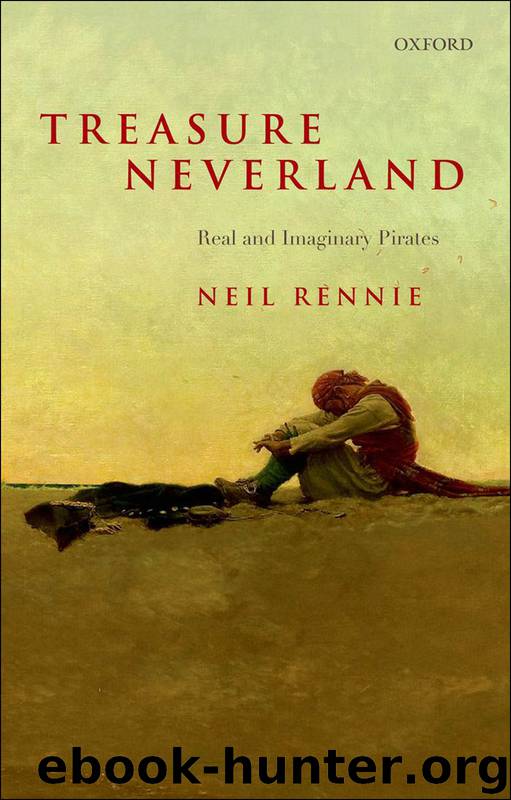Treasure Neverland by Neil Rennie

Author:Neil Rennie
Language: eng
Format: epub
Publisher: Oxford University Press
Published: 2013-02-25T16:00:00+00:00
Figure 6.1. ‘Captain Mackra, and the Pirate with a wooden leg’, from The Pirates Own Book (1837).
Although based on Irving’s and Cooper’s narratives, the opening of Treasure Island is more artfully arranged to build suspense. Stevenson’s pirates are horribly Gothic, not comically, like Irving’s, and especially so to the youthful Jim, Stevenson’s narrator. The menace of piracy is introduced to Jim’s father’s respectable Admiral Benbow inn by a series of injured but intimidating figures: scar-faced Billy Bones, the fierce guest with the mounting debt to Jim’s father; Black Dog, missing two of his fingers; and sinister Blind Pew. They are, of course, preparatory for the one-legged Long John Silver, the sea cook, the central character of Stevenson’s original title, as given to Henley almost immediately:
The Sea Cook
or Treasure Island:
A Story for Boys.44
In Wycherley’s The Plain-Dealer (1677) there is a running joke about wooden legs for sailors—‘Raillery upon wooden legs’—and we should remember, although he is better known today than in Stevenson’s day, Melville’s Gothic Captain Ahab, with his ‘ivory leg’ of whalebone.45 Injuries were suffered by real seamen, of course, especially those who chose to achieve ‘either a golden chain or a wooden leg’, like John Morris, and ships’ cooks were commonly chosen from sailors who were no longer able-bodied (see Figure 6.2), so Silver and Stevenson’s other maimed men are realistic, as well as Gothic, like the one-eyed sailor and scar-faced pirate of Irving’s ‘Money-Diggers’.46
The injured figures of Treasure Island connect Jim to piracy but also to treasure, a connection supposedly legitimized by Jim’s burglary of Billy Bones’s sea-chest to secure payment of the dead pirate’s bill at the inn. Billy Bones’s death looms larger in the narrative than the nearly simultaneous death of Jim’s innkeeper father, whose legacy to Jim takes the form, in narrative practice, of Billy Bones’s Treasure Island map, taken from his sea-chest. The pirates are potential father-figures. As keeper of the Spy-glass inn, Long John Silver is clearly a parallel to Jim’s own deceased father. But, although Jim is inheriting the wealth of the pirates, he sanctions his inheritance by securing more socially respectable father-figures, the doctor-magistrate Dr Livesey and the Squire Trelawney, who begin Treasure Island by authorizing Jim ‘to write down the whole particulars’.47
Treasure Island is essentially a competition between two groups for possession of treasure, a commodity vaguely defined but consisting, in its most attractive light, of unearned wealth. The respectable and unrespectable groups are differentiated principally by class, indicated by education and by pre-existing wealth. Both groups are motivated by greed for the treasure, the unearned wealth. ‘What were these villains after but money?’ asks the Squire rhetorically, before rejoicing with childish glee in the prospect, as possessors of the treasure map, of ‘finding the spot, and money to eat—to roll in—to play duck and drake with ever after’.48 This competition for loot which forms the plot, with its acquisition as the plot’s resolution, is not very different from the creaking machinery in previous nineteenth-century novels with events and outcomes
Download
This site does not store any files on its server. We only index and link to content provided by other sites. Please contact the content providers to delete copyright contents if any and email us, we'll remove relevant links or contents immediately.
| African | Asian |
| Australian & Oceanian | Canadian |
| Caribbean & Latin American | European |
| Jewish | Middle Eastern |
| Russian | United States |
4 3 2 1: A Novel by Paul Auster(12286)
The handmaid's tale by Margaret Atwood(7679)
Giovanni's Room by James Baldwin(7192)
Asking the Right Questions: A Guide to Critical Thinking by M. Neil Browne & Stuart M. Keeley(5641)
Big Magic: Creative Living Beyond Fear by Elizabeth Gilbert(5614)
Ego Is the Enemy by Ryan Holiday(5294)
The Body: A Guide for Occupants by Bill Bryson(4974)
On Writing A Memoir of the Craft by Stephen King(4863)
Ken Follett - World without end by Ken Follett(4645)
Adulting by Kelly Williams Brown(4487)
Bluets by Maggie Nelson(4474)
Eat That Frog! by Brian Tracy(4436)
Guilty Pleasures by Laurell K Hamilton(4361)
The Poetry of Pablo Neruda by Pablo Neruda(4040)
Alive: The Story of the Andes Survivors by Piers Paul Read(3969)
White Noise - A Novel by Don DeLillo(3954)
Fingerprints of the Gods by Graham Hancock(3942)
The Book of Joy by Dalai Lama(3901)
The Bookshop by Penelope Fitzgerald(3777)
